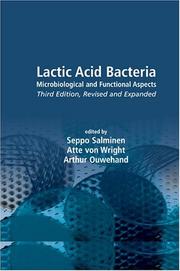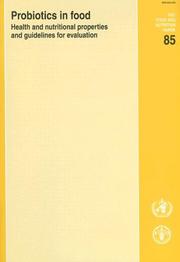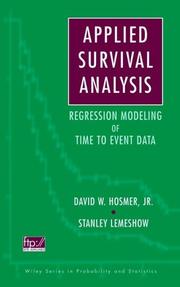| Listing 1 - 6 of 6 |
Sort by
|

ISBN: 9780824753320 0824753321 Year: 2004 Publisher: New York : Dekker,
Abstract | Keywords | Export | Availability | Bookmark
 Loading...
Loading...Choose an application
- Reference Manager
- EndNote
- RefWorks (Direct export to RefWorks)
This is a broad reference emphasizing health aspects, for microbiologists, food technologists, nutritionists, clinicians, product development specialists, and regulatory personnel. New contributors and some totally new chapters as well as revisions of previous material distinguish the third edition from the 1998 second. The topics include classification and physiology, an update on probiotic bifidobacteria, the industrial use and production of lactic acid bacteria, their genetics, methods for analyzing gut microbiota, vegetable fermentations, intestinal drug and cholesterol metabolism, the safety of novel probiotic bacteria, and lactic acid bacteria in fish and fish farming.
579.864 --- 579.264 --- 579.8 --- Lactobacillaceae. Lactobacillus --- Antagonism. Probiotics --- Classification and systematics of microoganisms --- 579.8 Classification and systematics of microoganisms --- 579.264 Antagonism. Probiotics --- 579.864 Lactobacillaceae. Lactobacillus --- Lactic acid bacteria
Dissertation
ISBN: 9789088260230 Year: 2007 Publisher: Leuven Katholieke Universiteit Leuven
Abstract | Keywords | Export | Availability | Bookmark
 Loading...
Loading...Choose an application
- Reference Manager
- EndNote
- RefWorks (Direct export to RefWorks)
There is a long history of health claims concerning living microorganisms in food. Already the Persian version of the Old Testament states that ‘Abraham owed his longevity to the consumption of sour milk.’ However, it was only at the beginning of last century that the health effects associated with the intake of fermented products (i.e. yoghurt) were for the first time linked to a shift in the intestinal microbial balance. Since then, the interest in gastrointestinal microbiota modulation has significantly increased, generating the idea that human health can be enhanced, and the risk of disease reduced by the consumption of health-promoting bacteria such as probiotics. Currently, probiotics are considered as ‘living microorganisms which, when administered in adequate amounts, confer a health benefit on the host.’ Although detailed molecular mechanisms underlying probiotic action are largely unknown, adhesion of these microorganisms, including lactobacilli, to the intestinal mucosa is considered one of the main properties to confer health effects. Despite the fact that Lactobacillus rhamnosus GG (LGG) is one of the clinically most studied probiotic organisms, and which selection as probiotic strain is mainly based on its ability to adhere to the intestinal mucosa, the molecular mechanisms mediating the adhesion of this strain are largely unstudied. In this work, a search for these factors was initiated. Both, a membrane-associated protein and the non-proteinaceous lipoteichoic acids (LTA) were studied in detail in relation to their role in LGG adhesion and host stimulation. During the last years the number of probiotic-containing food products introduced in the market has witnessed a strong increase. A microbiological analysis of seven bio-yoghurts available at the Columbian market was performed. Based on the results, some of the isolates were classified as potential probiotic strains, based on a comparison with LGG. However, not all of them were present in the advised amount to exert beneficial health effects. In addition to the consumption of probiotic-containing products, the consumption of food ingredients such as prebiotics is thought to provide beneficial effects in the gastrointestinal tract of humans and animals. Prebiotics are non-digestible food ingredients that benefit the host by selectively stimulating the growth and/or activity of one or a limited number of bacteria in the colon. In this work, the prebiotic potential of a specific non-digestible oligosaccharide was evaluated for LGG. Results indicated that although LGG is not able to ferment the tested compound as such, it plays an important role, be it most likely indirectly, in the modulation of important LGG metabolic pathways. Moreover, preliminary evaluation of the capacity of the non-digestible oligosaccharide indicated its possible potential as anti-inflammatory compound.
Academic collection --- 579.264 --- 577.2 --- 579.864 --- 579.864 Lactobacillaceae. Lactobacillus --- Lactobacillaceae. Lactobacillus --- 577.2 Molecular bases of life. Molecular biology --- Molecular bases of life. Molecular biology --- 579.264 Antagonism. Probiotics --- Antagonism. Probiotics --- Theses
Book
ISBN: 9781904455820 Year: 2011 Publisher: Norfolk : Caister Academic Press,
Abstract | Keywords | Export | Availability | Bookmark
 Loading...
Loading...Choose an application
- Reference Manager
- EndNote
- RefWorks (Direct export to RefWorks)
Acide lactique --- Lactic acid --- Bactérie lactique --- lactic acid bacteria --- Lactobacillus --- Stress oxydatif --- Oxidative stress --- Bifidobacterium --- Probiotique --- probiotics --- Flore microbienne --- microbial flora --- Bactériocine --- Bacteriocins --- 579.864 --- 579.264 --- 579.6 --- Lactobacillaceae. Lactobacillus --- Antagonism. Probiotics --- Applied microbiology --- 579.6 Applied microbiology --- 579.264 Antagonism. Probiotics --- 579.864 Lactobacillaceae. Lactobacillus --- Lactic acid bacteria --- Bifidobacteria --- Actinomycetaceae

ISBN: 9251055130 Year: 2006 Publisher: Rome : FAO,
Abstract | Keywords | Export | Availability | Bookmark
 Loading...
Loading...Choose an application
- Reference Manager
- EndNote
- RefWorks (Direct export to RefWorks)
Dietary supplements --- Food --- Lactic acid bacteria --- Microbial biotechnology --- 579.264 --- Microorganisms --- Biotechnology --- Industrial microbiology --- Biotechnological microorganisms --- Sanitary microbiology --- Food biotechnology --- Genetically modified foods --- Diet supplements --- Food supplements --- Nutrient supplements --- Nutritional supplements --- Supplements, Nutritional --- Food additives --- Nutrition --- Vitamins --- 579.264 Antagonism. Probiotics --- Antagonism. Probiotics --- Microbiology --- Bacteriology --- Conferences - Meetings --- Food. --- Dietary Supplements. --- Dietary Supplements --- Probiotics
Multi
ISBN: 9789059892637 Year: 2008 Publisher: Gent : Universiteit Gent. Faculteit bio-ingenieurswetenschappen,
Abstract | Keywords | Export | Availability | Bookmark
 Loading...
Loading...Choose an application
- Reference Manager
- EndNote
- RefWorks (Direct export to RefWorks)
Larve de poisson --- Fish larvae --- Aquaculture --- aquaculture --- Micro-organisme --- microorganisms --- Rotifera --- Artemia --- Alimentation des poissons --- Fish feeding --- Probiotique --- probiotics --- Contrôle de maladies --- Disease control --- Sciences and engineering --- biological sciences --- biology --- microbiology --- 639.3.03 --- 579.264 --- 639.3.043 --- Reproductive processes of fish. Propagation of fish. Hybridization. Fertilization. Egg-laying. Fish eggs and larvae --- Antagonism. Probiotics --- Feeding, nutrition of fish. Fish foods --- 639.3.043 Feeding, nutrition of fish. Fish foods --- 579.264 Antagonism. Probiotics --- 639.3.03 Reproductive processes of fish. Propagation of fish. Hybridization. Fertilization. Egg-laying. Fish eggs and larvae --- microbiology. --- aquaculture. --- Brachionus Plicatilis --- Prébiotique --- Biological sciences --- Biology --- Microbiology.

ISBN: 0471154105 047119025X 9780471154105 Year: 1999 Publisher: New York: Wiley,
Abstract | Keywords | Export | Availability | Bookmark
 Loading...
Loading...Choose an application
- Reference Manager
- EndNote
- RefWorks (Direct export to RefWorks)
Biomathematics. Biometry. Biostatistics --- Mathematical statistics --- Quantitative methods (economics) --- Medicine --- Medical sciences --- Regression analysis --- Prognosis --- Logistic distribution. --- Médecine --- Analyse de régression --- Research --- Statistical methods. --- Statistical methods --- Computer programs. --- Data processing. --- Recherche --- Méthodes statistiques --- Informatique --- Logistic distribution --- Computer programs --- Data processing --- 579.6 --- 579.264 --- 579.864 --- Food --- -Intestines --- -Microorganisms --- -Germs --- Micro-organisms --- Microbes --- Microscopic organisms --- Organisms --- Microbiology --- Abdomen --- Gastrointestinal system --- Foods --- Dinners and dining --- Home economics --- Table --- Cooking --- Diet --- Dietaries --- Gastronomy --- Nutrition --- Applied microbiology --- Antagonism. Probiotics --- Lactobacillaceae. Lactobacillus --- -Handbooks, manuals, etc --- Therapeutic use --- 519.22 --- -Medical sciences --- -Regression analysis --- -Prognosis --- -Logistic distribution --- gezondheidszorg --- regressie-analyse --- wiskundige statistiek --- AA / International- internationaal --- 303.5 --- 519.536 --- Distribution (Probability theory) --- Medical prognosis --- Prognosis of diseases --- Forecasting --- Diagnosis --- Analysis, Regression --- Linear regression --- Regression modeling --- Multivariate analysis --- Structural equation modeling --- Basic medical sciences --- Basic sciences, Medical --- Biomedical sciences --- Health sciences --- Preclinical sciences --- Sciences, Medical --- Life sciences --- Clinical sciences --- Medical profession --- Human biology --- Pathology --- Physicians --- Statistical theory. Statistical models. Mathematical statistics in general --- -Statistical methods --- -Computer programs --- Theorie van correlatie en regressie. (OLS, adjusted LS, weighted LS, restricted LS, GLS, SLS, LIML, FIML, maximum likelihood). Parametric and non-parametric methods and theory (wiskundige statistiek). --- Intestines --- Microorganisms --- Probiotics --- Bacterial Physiology. --- Food, Formulated. --- pharmacology. --- therapeutic use. --- -Applied microbiology --- 579.864 Lactobacillaceae. Lactobacillus --- 579.264 Antagonism. Probiotics --- 579.6 Applied microbiology --- 519.22 Statistical theory. Statistical models. Mathematical statistics in general --- -579.864 Lactobacillaceae. Lactobacillus --- Germs --- Médecine --- Analyse de régression --- Méthodes statistiques --- Statistical methods&delete& --- Research&delete& --- Theorie van correlatie en regressie. (OLS, adjusted LS, weighted LS, restricted LS, GLS, SLS, LIML, FIML, maximum likelihood). Parametric and non-parametric methods and theory (wiskundige statistiek) --- Probiotic supplements --- Dietary supplements --- Health Workforce --- Primitive societies --- Medicine - Research - Statistical methods --- Medical sciences - Statistical methods - Computer programs --- Regression analysis - Data processing --- Prognosis - Statistical methods
| Listing 1 - 6 of 6 |
Sort by
|

 Search
Search Feedback
Feedback About UniCat
About UniCat  Help
Help News
News